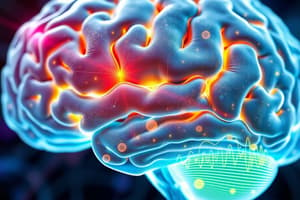Podcast
Questions and Answers
What is the primary reason for including a test of general intelligence in a neuropsychological test battery?
What is the primary reason for including a test of general intelligence in a neuropsychological test battery?
It helps provide a baseline measure of cognitive function, despite its limitations in assessing brain damage.
Name two subtests from the verbal comprehension category of the WAIS.
Name two subtests from the verbal comprehension category of the WAIS.
Information and Vocabulary.
What does the Picture Completion subtest require patients to do?
What does the Picture Completion subtest require patients to do?
Identify the important part missing from a drawing.
Explain how the Digit Span subtest is conducted.
Explain how the Digit Span subtest is conducted.
What is one criticism of the WAIS regarding memory assessment?
What is one criticism of the WAIS regarding memory assessment?
Describe the task involved in the Letter-Number Sequencing subtest.
Describe the task involved in the Letter-Number Sequencing subtest.
How does the Matrix Reasoning subtest evaluate a patient's cognitive abilities?
How does the Matrix Reasoning subtest evaluate a patient's cognitive abilities?
What skills does the Cancellation subtest primarily assess?
What skills does the Cancellation subtest primarily assess?
What cognitive functions are primarily evaluated through the Block Design subtest?
What cognitive functions are primarily evaluated through the Block Design subtest?
What furniture piece in a neuropsychological assessment may fail to identify memory issues?
What furniture piece in a neuropsychological assessment may fail to identify memory issues?
What is conditioned taste aversion and how does it illustrate the concept of associative learning?
What is conditioned taste aversion and how does it illustrate the concept of associative learning?
Describe the purpose of the Morris water maze in studying spatial memory.
Describe the purpose of the Morris water maze in studying spatial memory.
What does the term 'converging operations' mean in biopsychology research methods?
What does the term 'converging operations' mean in biopsychology research methods?
Explain conditioned defensive burying and its significance in understanding animal behavior.
Explain conditioned defensive burying and its significance in understanding animal behavior.
How do neuroplasticity and the evolutionary perspective contribute to our understanding of the brain in biopsychology?
How do neuroplasticity and the evolutionary perspective contribute to our understanding of the brain in biopsychology?
What are the three types of language-related problems a patient may exhibit if they have speech issues?
What are the three types of language-related problems a patient may exhibit if they have speech issues?
How can brain damage affect a patient's ability to read aloud?
How can brain damage affect a patient's ability to read aloud?
What is the primary purpose of the Wisconsin Card Sorting Test?
What is the primary purpose of the Wisconsin Card Sorting Test?
What does perseveration mean in the context of the Wisconsin Card Sorting Test?
What does perseveration mean in the context of the Wisconsin Card Sorting Test?
What assumptions underlie cognitive neuroscience?
What assumptions underlie cognitive neuroscience?
What is the goal of cognitive neuroscience?
What is the goal of cognitive neuroscience?
What is the paired-image subtraction technique used for?
What is the paired-image subtraction technique used for?
In the paired-image subtraction technique, what differentiates the tasks from each other?
In the paired-image subtraction technique, what differentiates the tasks from each other?
Why is it important to test neuropsychological patients with speech problems comprehensively?
Why is it important to test neuropsychological patients with speech problems comprehensively?
What role do PET and fMRI play in cognitive neuroscience?
What role do PET and fMRI play in cognitive neuroscience?
What is a mean difference image, and how is it beneficial in brain imaging studies?
What is a mean difference image, and how is it beneficial in brain imaging studies?
Describe the role of signal averaging in the creation of mean difference images.
Describe the role of signal averaging in the creation of mean difference images.
What are species-common behaviors, and why are they important in biopsychological research?
What are species-common behaviors, and why are they important in biopsychological research?
Explain the open-field test and what it measures in laboratory rats.
Explain the open-field test and what it measures in laboratory rats.
What does thigmotaxis indicate about a rat's behavior in the open-field test?
What does thigmotaxis indicate about a rat's behavior in the open-field test?
Describe the colony-intruder paradigm and its significance in studying aggressive behavior.
Describe the colony-intruder paradigm and its significance in studying aggressive behavior.
How do repeated exposures to the open field influence a rat's behavior over time?
How do repeated exposures to the open field influence a rat's behavior over time?
What are some other common species-common behaviors studied in laboratory rats?
What are some other common species-common behaviors studied in laboratory rats?
Why is averaging images from multiple volunteers important in neuroimaging studies?
Why is averaging images from multiple volunteers important in neuroimaging studies?
What factors are typically considered indicators of fearfulness in the open-field test?
What factors are typically considered indicators of fearfulness in the open-field test?
How does a conditional stimulus evolve to elicit a conditional response in Pavlovian conditioning?
How does a conditional stimulus evolve to elicit a conditional response in Pavlovian conditioning?
What role do reinforcement and punishment play in operant conditioning?
What role do reinforcement and punishment play in operant conditioning?
Describe the main characteristic of a conditioned taste aversion.
Describe the main characteristic of a conditioned taste aversion.
What is the purpose of the radial arm maze in studying animal learning?
What is the purpose of the radial arm maze in studying animal learning?
How does the Morris water maze assess spatial abilities in rats?
How does the Morris water maze assess spatial abilities in rats?
In operant conditioning, what is the self-stimulation paradigm?
In operant conditioning, what is the self-stimulation paradigm?
What do the results from conditioned defensive burying indicate about animal behavior?
What do the results from conditioned defensive burying indicate about animal behavior?
How do learning paradigms help in understanding animal motivation?
How do learning paradigms help in understanding animal motivation?
What distinct learning opportunity does a single trial provide in conditioned taste aversion?
What distinct learning opportunity does a single trial provide in conditioned taste aversion?
Explain the significance of using seminatural animal learning paradigms.
Explain the significance of using seminatural animal learning paradigms.
Flashcards are hidden until you start studying
Study Notes
Neuropsychological Test Battery
- Commonly includes a measure of general intelligence, despite limitations in assessing brain damage.
- Wechsler Adult Intelligence Scale (WAIS) consists of 15 subtests categorized under:
- Verbal Comprehension: Tests general knowledge and vocabulary understanding (e.g., Information, Vocabulary, Comprehension, Similarities).
- Perceptual Reasoning: Evaluates visual-spatial skills (e.g., Picture Completion, Matrix Reasoning, Block Design, Figure Weights, Visual Puzzles).
- Working Memory: Assesses ability to manage and manipulate information (e.g., Digit Span, Arithmetic, Letter-Number Sequencing).
- Processing Speed: Measures speed of information processing (e.g., Symbol Search, Coding, Cancellation).
- WAIS memory subtests may overlook deficits, despite measuring various memory functions.
Mean Difference Images
- Used in PET and fMRI studies to improve signal-to-noise ratio.
- Involves averaging images from multiple test repetitions to emphasize common brain activity.
- Creates mean difference images, spotlighting areas of consistent activity across participants.
Biopsychological Paradigms of Animal Behavior
- Behavioral paradigms help assess species-common behaviors in laboratory rats.
- Species-common behaviors include actions like grooming, eating, and defending.
- Open-Field Test measures anxiety and activity; low activity and high fecal bolus counts indicate fearfulness.
- Colony-Intruder Paradigm studies aggressive and defensive behaviors during rat confrontations.
Cognitive Assessment and Frontal Lobe Function
- Wisconsin Card Sorting Test assesses cognitive flexibility and frontal lobe integrity.
- Patients often display perseveration, continuing to sort using an incorrect rule for extended trials.
Cognitive Neuroscience and Research Methods
- Combines techniques to identify cognitive processes activated during tasks.
- Paired-Image Subtraction Technique utilized in PET and fMRI; aids in isolating specific cognitive processes by comparing brain images during different tasks.
Learning Paradigms
- Pavlovian Conditioning involves associating neutral stimuli with unconditioned responses (e.g., sound and salivation).
- Operant Conditioning examines how reinforcement affects voluntary behaviors (e.g., lever pressing).
Seminatural Animal Learning Paradigms
- Simulate real-life learning scenarios:
- Conditioned Taste Aversion: Rats avoid tastes associated with illness after a single exposure.
- Radial Arm Maze: Assesses spatial learning; rats navigate arms based on previous experiences.
- Morris Water Maze: Evaluates spatial memory through finding a submerged escape platform.
- Conditioned Defensive Burying: Rats bury a painful stimulus, showcasing learned avoidance behavior.
Language and Cognitive Assessment
- Detailed tests for language deficits depending on speech problems (phonology, syntax, semantics).
- Differentiates between reading disruption patterns, aiding diagnosis in dyslexic patients.
Research Methodologies in Biopsychology
- Emphasizes converging operations, combining multiple research methods to address complex problems.
- Highlights themes like neuroplasticity, evolutionary perspective, and clinical implications relating to brain and behavior relationships.
Studying That Suits You
Use AI to generate personalized quizzes and flashcards to suit your learning preferences.





